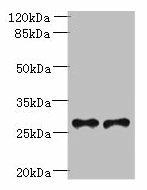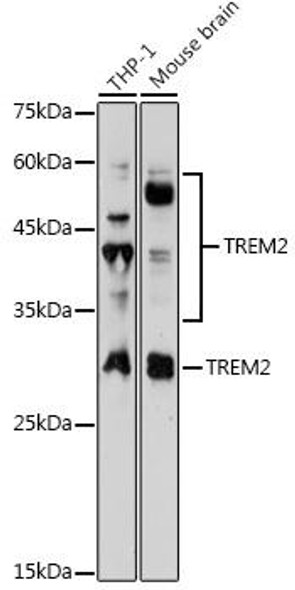Description
Trem2 Antibody (PACO30798)
The TREM2 Monoclonal Antibody (PACO30798) is a valuable tool for research involving triggering receptor expressed on myeloid cells 2 (TREM2), a protein associated with immune response and neurodegenerative diseases. This antibody, produced in mice, is highly specific for human samples and has been validated for use in various applications, including immunofluorescence and flow cytometry.TREM2 is a transmembrane receptor expressed on microglia and macrophages in the brain, playing a key role in regulating immune responses and phagocytosis. Dysregulation of TREM2 has been linked to Alzheimer's disease and other neurodegenerative disorders, making it an important target for research aimed at understanding the pathogenesis of these conditions.
By using the PACO30798 antibody, researchers can study the expression and function of TREM2 in different cell types and tissues, providing valuable insights into its involvement in neuroinflammation and neurodegenerative diseases. This antibody is an essential tool for scientists researching immunology, neuroscience, and drug development related to TREM2 signaling pathways.
| Antibody Name: | Trem2 Antibody (PACO30798) |
| Antibody SKU: | PACO30798 |
| Size: | 50ug |
| Host Species: | Rabbit |
| Tested Applications: | ELISA, WB |
| Recommended Dilutions: | ELISA:1:2000-1:10000, WB:1:500-1:2000 |
| Species Reactivity: | Mouse, Human |
| Immunogen: | Recombinant Mouse Triggering receptor expressed on myeloid cells 2 protein (19-171AA) |
| Form: | Liquid |
| Storage Buffer: | Preservative: 0.03% Proclin 300 Constituents: 50% Glycerol, 0.01M PBS, PH 7.4 |
| Purification Method: | >95%, Protein G purified |
| Clonality: | Polyclonal |
| Isotype: | IgG |
| Conjugate: | Non-conjugated |
 | Western blot All lanes: Trem2 antibody at 6µg/ml Lane 1: Mouse liver tissue Lane 2: THP-1 whole cell lysate Secondary Goat polyclonal to rabbit IgG at 1/10000 dilution Predicted band size: 25, 28 kDa Observed band size: 28 kDa . |
| Background: | May have a role in chronic inflammations and may stimulate production of constitutive rather than inflammatory chemokines and cytokines. Forms a receptor signaling complex with TYROBP and triggers activation of the immune responses in macrophages and dendritic cells. |
| Synonyms: | Triggering receptor expressed on myeloid cells 2 (TREM-2) (Triggering receptor expressed on monocytes 2), Trem2, Trem2a Trem2b Trem2c |
| UniProt Protein Function: | TREM2: May have a role in chronic inflammations and may stimulate production of constitutive rather than inflammatory chemokines and cytokines. Forms a receptor signaling complex with TYROBP and triggers activation of the immune responses in macrophages and dendritic cells. Defects in TREM2 are a cause of polycystic lipomembranous osteodysplasia with sclerosing leukoencephalopathy (PLOSL); also known as presenile dementia with bone cysts or Nasu-Hakola disease (NHD). PLOSL is a recessively inherited disease characterized by a combination of psychotic symptoms rapidly progressing to presenile dementia and bone cysts restricted to wrists and ankles. PLOSL has a global distribution, although most of the patients have been diagnosed in Finland and Japan, with an estimated population prevalence of 2x10(-6) in the Finns. 3 isoforms of the human protein are produced by alternative splicing. |
| UniProt Protein Details: | Protein type:Membrane protein, integral Cellular Component: integral to membrane; intracellular membrane-bound organelle Molecular Function:lipopolysaccharide binding; peptidoglycan binding; protein binding; transmembrane receptor activity Biological Process: detection of lipopolysaccharide; detection of peptidoglycan; innate immune response; lipopolysaccharide-mediated signaling pathway; phagocytosis, engulfment; positive regulation of antigen processing and presentation of peptide antigen via MHC class II; positive regulation of calcium-mediated signaling; positive regulation of peptidyl-tyrosine phosphorylation |
| NCBI Summary: | The protein encoded by this gene is part of the immunoglobulin and lectin-like superfamily and functions as part of the innate immune system. This gene forms part of a cluster of genes on mouse chromosome 17 thought to be involved in innate immunity. This protein associates with the adaptor protein Dap-12 and recruits several factors, such as kinases and phospholipase C-gamma, to form a receptor signaling complex that activates myeloid cells, including dendritic cells and microglia. In humans homozygous loss-of-function mutations in this gene cause Nasu-Hakola disease and mutations in this gene may be risk factors to the development of Alzheimer's disease. In mouse mutations of this gene serve as a pathophysiological model for polycystic lipomembranous osteodysplasia with sclerosing leukoencephalopathy (Nasu-Hakola disease) and for inflammatory bowel disease. Alternative splicing results in multiple transcript variants that encode different protein isoforms. [provided by RefSeq, Jan 2013] |
| UniProt Code: | Q99NH8 |
| NCBI GenInfo Identifier: | 50401660 |
| NCBI Gene ID: | 83433 |
| NCBI Accession: | Q99NH8.1 |
| UniProt Secondary Accession: | Q99NH8,Q8CGK4, Q8CIA6, Q99NH9, Q9JL34, |
| UniProt Related Accession: | Q99NH8 |
| Molecular Weight: | 27,304 Da |
| NCBI Full Name: | Triggering receptor expressed on myeloid cells 2 |
| NCBI Synonym Full Names: | triggering receptor expressed on myeloid cells 2 |
| NCBI Official Symbol: | Trem2 |
| NCBI Official Synonym Symbols: | TREM-2; Trem2a; Trem2b; Trem2c |
| NCBI Protein Information: | triggering receptor expressed on myeloid cells 2 |
| UniProt Protein Name: | Triggering receptor expressed on myeloid cells 2 |
| UniProt Synonym Protein Names: | Triggering receptor expressed on monocytes 2 |
| Protein Family: | Triggering receptor expressed on myeloid cells |
| UniProt Gene Name: | Trem2 |
| UniProt Entry Name: | TREM2_MOUSE |








